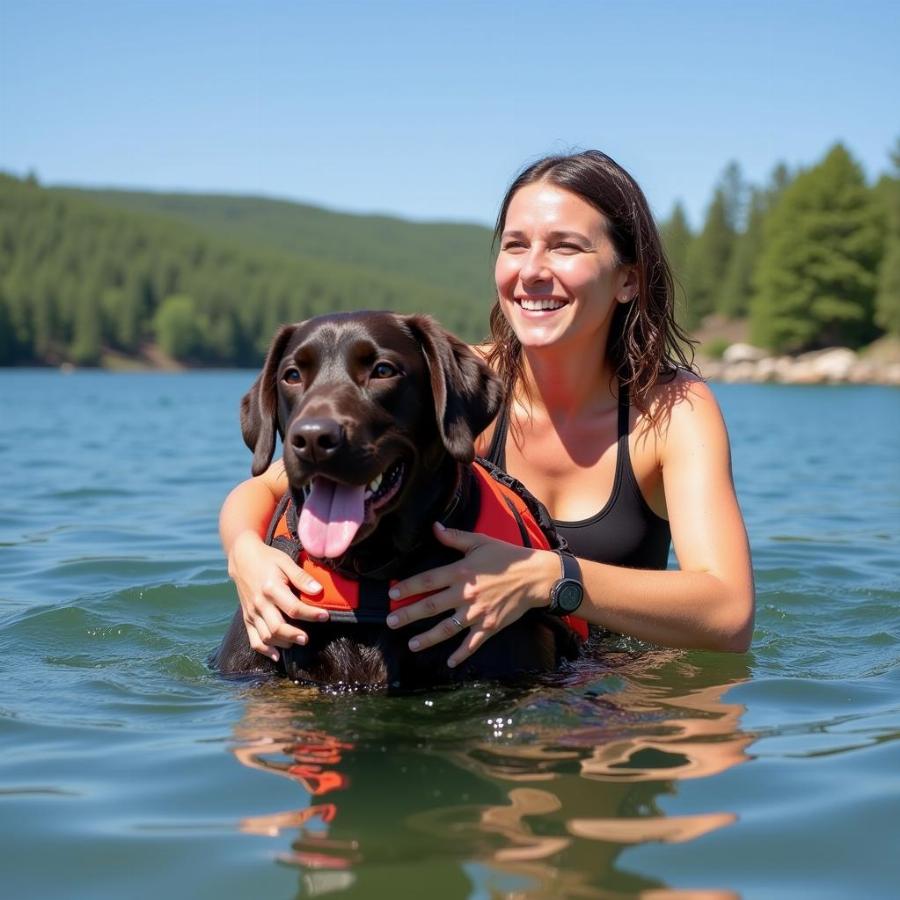The phrase “Prado Madrid drowning dog” paints a disturbing picture, highlighting the potential dangers dogs face around water. While the specific incident behind the phrase remains unclear, it serves as a crucial reminder of the importance of water safety for our beloved canine companions. Whether you’re enjoying a day by the pool, a trip to the beach, or a walk near a body of water, understanding the risks and taking preventative measures is paramount to keeping your furry friend safe.
Understanding the Risks: Why Water Safety is Crucial for Dogs
Not all dogs are natural swimmers. While some breeds, like Retrievers and Newfoundlands, have an innate affinity for water, others may struggle or even panic. Even strong swimmers can become exhausted or disoriented, especially in challenging conditions like strong currents, cold water, or rough waves. Understanding your dog’s individual swimming abilities and limitations is the first step towards ensuring their safety.
Essential Water Safety Tips for Dog Owners
Being prepared is key to preventing accidents. Here are some essential water safety tips for all dog owners:
- Invest in a Dog Life Vest: Even if your dog is a confident swimmer, a life vest provides added buoyancy and visibility, especially in open water or challenging conditions. Choose a vest with bright colors and handles for easy retrieval.
- Supervise Closely: Never leave your dog unsupervised near water, regardless of their swimming abilities. Keep a watchful eye on them at all times and be prepared to intervene if necessary.
- Gradual Introduction to Water: Introduce your dog to water gradually and positively. Start in shallow areas and allow them to explore at their own pace. Avoid forcing them into the water, as this can create fear and anxiety.
- Teach Basic Swimming Skills: If your dog isn’t a natural swimmer, consider teaching them basic swimming skills. Use positive reinforcement and encourage them with toys or treats. Professional dog trainers can also provide guidance and support.
- Be Aware of Potential Hazards: Be mindful of potential hazards such as strong currents, undertows, sharp rocks, and slippery surfaces. Avoid areas with heavy boat traffic or other potential dangers.
 Dog Swimming With Owner
Dog Swimming With Owner
What to Do in a Water Emergency
Knowing how to react in a water emergency can save your dog’s life.
- Remain Calm: Panicking will only worsen the situation. Assess the situation quickly and calmly to determine the best course of action.
- Call for Help if Needed: If your dog is struggling in deep water or strong currents, call for help immediately. Lifeguards or emergency services may be able to assist with the rescue.
- Retrieve Your Dog Safely: If possible, retrieve your dog from the water yourself, using a flotation device or reaching pole if necessary. Avoid putting yourself in danger.
- Administer First Aid: Once your dog is out of the water, check for signs of distress, such as difficulty breathing or unconsciousness. Administer first aid if necessary and seek veterinary care immediately.
Is My Dog a Strong Swimmer? Recognizing the Signs
How can you tell if your dog is a strong swimmer? Some breeds are naturally inclined towards water, while others may require more support. Observe your dog’s behavior in the water. A dog that paddles comfortably, keeps its head above water, and seems relaxed and confident is likely a strong swimmer. However, a dog that struggles, panics, or sinks may need assistance.
Conclusion
The phrase “prado madrid drowning dog” serves as a sobering reminder of the potential dangers dogs face around water. By understanding the risks, taking preventative measures, and knowing how to react in an emergency, we can help ensure our furry friends enjoy safe and happy experiences around water. Prioritizing water safety is a crucial aspect of responsible dog ownership.
FAQ:
- What type of life vest is best for my dog?
- How can I teach my dog to swim?
- What should I do if my dog ingests a large amount of water?
- Are there any breeds that should avoid water altogether?
- What are the signs of water intoxication in dogs?
- How can I make my pool area safer for my dog?
- Where can I find dog-friendly swimming areas near me?
Related Articles:
- Dog First Aid Basics
- Choosing the Right Dog Breed for Your Lifestyle
- Summer Safety Tips for Dogs
Beaut Dogs is your go-to resource for all things canine, providing reliable and insightful information about the world of dogs. From breed-specific guides to expert advice on care and training, we’re here to help you navigate the joys and responsibilities of dog ownership. For personalized support and detailed answers to your questions, contact us at [email protected]. Visit https://beautdogs.com today to explore our comprehensive resources and discover the wonderful world of dogs!